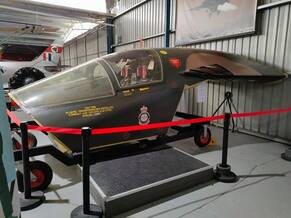General Dynamics F-111C Crew Module A8-131
 Click on image for larger version
Click on image for larger version
The General Dynamics F-111C aircraft commenced service with the RAAF in 1973 after being chosen to replace the CAC Canberra ahead of the British TSR2. 24 were deployed and served in Squadron Nos 1 and 6 with A8 serials. Later, four ex-USAF aircraft were purchased to replace losses. In addition, Australia operated fifteen USAF F-111Cs between 1993 and 2207 and a further 10 aircraft were held in storage in the US for spare parts and other requirements.
Only 4 ejections occurred during the aircraft's RAAF service, one of which was over water near Auckland New Zealand from aircraft A8-141. The crew reported the module worked "as advertised" and only minor injuries were sustained.
Retirement of the F111Cs commenced in 2007 and finished in December 2010 with the last RAAF F-111C flight occurring on December 3rd 2010. After vigorous campaigning by Museums and other interested parties, thirteen of the aircraft and eight Crew Escape Modules were preserved for distribution between RAAF Bases and Museums.
In 2011the fuselages of 23 F111Cs not earmarked for preservation were buried in Queensland, with wings and other components scrapped, as apparently required by the terms of the original purchase.
The Museum's F111C Crew Escape Module came from aircraft A8-131 and arrived at the Museum on June 28th 2013, and is currently on display.
TECHNICAL DATA - AIRCRAFT
Crew : 2
Power plant : 2 x 17,900 lbs thrust Pratt and Whitney TF30-P-100 afterburning turbofan engines.
Length : 73'06'' (22.4m) Wingspan : 70'00'' (21.33m) Height : 17'02'' (5.22m)
Weights : empty - 47,179lbs (21,400kg) maximum - 110,002lbs (49,896kg)
Speeds : maximum - Mach 1.2 at sea level, Mach 2.5 above 50,000ft (15,200m)
cruise - 420kt (504mph) (780km/hr)
Combat range : 1,330 miles (2,150km)
Rate of climb : 25,890ft/min.
Ceiling : 66,000ft (20,000m)
Armament : 1 x M61 Vulcan 20mm Gatling canon.
Ordnance : 9 under wing hard points with a total capacity of 31,500lbs (14,288kg)
Only 4 ejections occurred during the aircraft's RAAF service, one of which was over water near Auckland New Zealand from aircraft A8-141. The crew reported the module worked "as advertised" and only minor injuries were sustained.
Retirement of the F111Cs commenced in 2007 and finished in December 2010 with the last RAAF F-111C flight occurring on December 3rd 2010. After vigorous campaigning by Museums and other interested parties, thirteen of the aircraft and eight Crew Escape Modules were preserved for distribution between RAAF Bases and Museums.
In 2011the fuselages of 23 F111Cs not earmarked for preservation were buried in Queensland, with wings and other components scrapped, as apparently required by the terms of the original purchase.
The Museum's F111C Crew Escape Module came from aircraft A8-131 and arrived at the Museum on June 28th 2013, and is currently on display.
TECHNICAL DATA - AIRCRAFT
Crew : 2
Power plant : 2 x 17,900 lbs thrust Pratt and Whitney TF30-P-100 afterburning turbofan engines.
Length : 73'06'' (22.4m) Wingspan : 70'00'' (21.33m) Height : 17'02'' (5.22m)
Weights : empty - 47,179lbs (21,400kg) maximum - 110,002lbs (49,896kg)
Speeds : maximum - Mach 1.2 at sea level, Mach 2.5 above 50,000ft (15,200m)
cruise - 420kt (504mph) (780km/hr)
Combat range : 1,330 miles (2,150km)
Rate of climb : 25,890ft/min.
Ceiling : 66,000ft (20,000m)
Armament : 1 x M61 Vulcan 20mm Gatling canon.
Ordnance : 9 under wing hard points with a total capacity of 31,500lbs (14,288kg)
